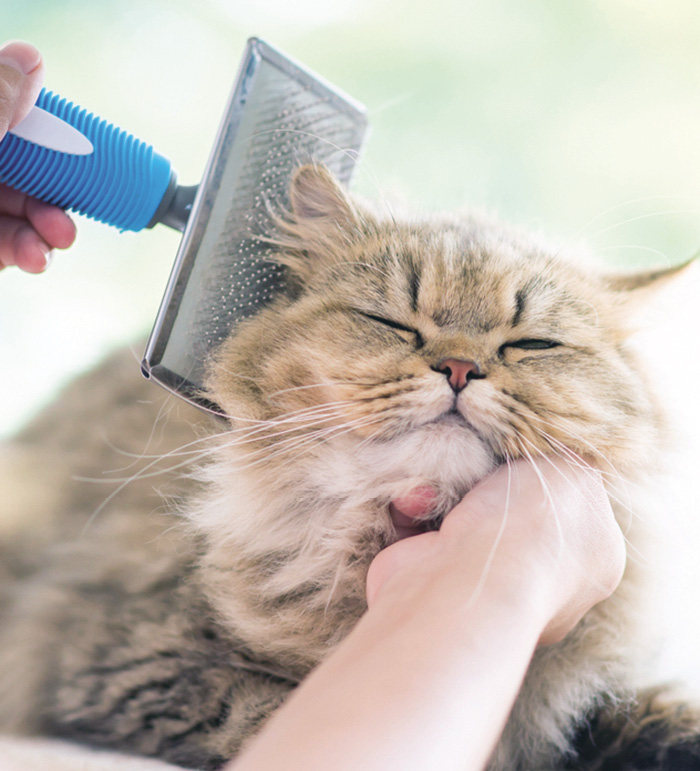Is your normally gorgeous cat looking more like an alley cat these days? For the most part, our feline friends keep themselves neat and tidy on their own. But longhaired, senior, obese, and sick cats often need extra help to keep their coats shiny and clean.
Start Young
“Start grooming your cat when they are young,” says Brittany Papa, Cornell University College of Veterinary Medicine Class of 2023. Older cats can be taught to enjoy grooming, too, but starting while your cat is a kitten allows you to make grooming a regular part of her routine so that she is used to it well before it becomes a necessity. Plus, grooming your cat can be a wonderful bonding opportunity.
Find Tools Your Cat Likes
“Different cats like different types of brushes, so experiment to find one your cat likes best!” says Kelly Hume, DVM, board-certified oncologist and professor of oncology at Cornell University’s College of Veterinary Medicine.
There are lots of options:
- Combs in a variety of materials
- Nylon bristle brushes
- Rubber grooming gloves
- Slicker brushes with metal tines
- Wooden-bristle brushes
Senior cats may prefer gentler wooden-bristle brushes, while combs may be most helpful for longhaired cats. Try borrowing a variety of tools to decide what your cat likes before you buy one, if you can.
Short Sessions
“Keep sessions short, especially at first,” says Amy Chase, LVT, former veterinary technician at Cornell University’s College of Veterinary Medicine. Work on your cat’s coat just a little bit and quit while she is still happy about the attention. Better to leave your cat wanting more than to overdo it. This might mean just doing one or two passes with the brush at a time. You can repeat these small sessions throughout the day or week.
Use Rewards
Many cats come to enjoy grooming, but some extra incentive doesn’t hurt. “It’s important to keep these experiences positive and to give positive reinforcement with calming words of praise and/or treats for good behavior if first starting to groom a cat,” says Bruce Kornreich, DVM, PhD, board-certified veterinary cardiologist at Cornell University’s College of Veterinary Medicine and director of the Cornell Feline Health Center.
Give your cat treats during grooming sessions or break out a favorite toy. You can also groom your cat a little while she eats. And don’t forget the power of praise. All these strategies help to make grooming a positive activity, so your cat thinks of treats, toys, and attention when she sees the brush.
Skip Baths
“Don’t bathe your cat too often,” says Dr. Kornreich. Most cats do not require regular baths, and bathing too much can dry out their skin and affect coat health. Save bath time for when your cat really needs it, such as after a bout of diarrhea that stains the fur.
Start Good Habits
Getting your cat used to having her entire body groomed gradually and then grooming a little bit on a regular basis will pay off in the long run. “I had a longhaired cat once who was very prone to hair mat formation if I didn’t keep her brushed daily,” says James Flanders, DVM, board-certified surgeon and professor emeritus of surgery at Cornell University’s College of Veterinary Medicine. “She enjoyed the back brushes but wasn’t keen on getting her thighs brushed. I’d wished that I had started out brushing her daily when she was a kitten so that she was more cooperative. So, my recommendation is to start early in life with full-body brushing (even the belly) if you want to keep your long-haired cat well-coiffed.”
Brushing daily, even just a little, will both keep your cat’s coat in good condition and keep her accustomed to grooming being part of your routine.
This goes for nail trimming too. Trimming your cat’s nails every other week or once a month while she is young and active will set you up for success if she has trouble wearing down her nails in her senior years. When starting out, just clip one or two nails at a time before rewarding her and/or taking a break.
Be Patient
“Work with what the cat gives you,” says Jon Doheny, DVM, Cornell University College of Veterinary Medicine Class of 2019. “I have two adult brother littermates at home (they were Cornell teaching cats he adopted), one of them I either distract or wait until he’s sleeping to cut his nails. The other brother is too wary to sneak around or distract but responds well to light restraint. The personality/preferences of the cat matters when deciding upon the approach.”
The “less-is-more” strategy works for many cats. Others respond well to being wrapped in a towel for maintenance grooming such as nail trims, ear cleaning, or sanitary grooming on the back end. Do what makes your cat happy.
No Scissors
“If a mat comes up, please don’t use scissors to cut it out. So many cats end up with lacerations in their skin due to owners grooming with scissors,” says Dana Muir-Preston, DVM, Cornell University College of Veterinary Medicine Class of 2012. If you must cut out a mat, slide a comb between the cat’s skin and the beginning of the mat to avoid the scissors touching the skin.
Shaving clippers are the best choice, however, and the least likely to damage your cat’s delicate skin. For severely matted cats, a full-body shave by a groomer may be in order. This gives both you and your cat a clean slate, and you can work on setting good grooming habits as the hair grows back to prevent future mats from forming.
Teeth Too
“Getting your cat used to having their teeth brushed can help improve oral health tremendously and lead to fewer dental problems down the line,” says Elizabeth Klueber, DVM, Cornell University College of Veterinary Medicine Class of 2019. Start by letting your cat lick cat-friendly toothpaste off a toothbrush every day, then gradually work up to brushing her mouth. This process can take several months.
A Sense of Humor
“Chain mail gloves, bourbon, and band aids,” says William H. Miller Jr., VMD, board-certified veterinary dermatologist and professor emeritus of medicine at Cornell University’s College of Veterinary Medicine. “If the grooming is introduced at a very young age and is gradually built up in time and intensity things usually go well. Slow and steady wins the race with kittens but may not be true with the rescue cat you get.”
If things go awry, take a break so everyone can calm down. Then do something basic with your cat, such as running the brush across her back once, so that you can praise and reward her and end the session on a positive note. Next time, try a different approach or proceed more slowly.
And save the bourbon for after you finish grooming.




